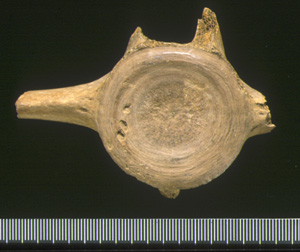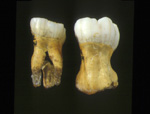|
Transition
 |
Levallois
artefacts. Oxygen Isotope Stages 8 and 7. |
 |
Dolphin
vertebra from Grays Thurrock, Essex, with probable carnivore tooth
marks. This rare fossil of a cetacean indicates a high sea level
and estuarine conditions nearby. |
 |
Hominid
alteration of bones. Cutmarks on a set of brown bear metapodials
from Grays Thurrock, Essex (OIS 9). Spectacular evidence for human
accumulation of a large mammal assemblage comes from an extensive
early nineteenth century collection of vertebrate remains recovered
from clay pits at Grays. The cutmarks went un-noticed until recently,
and artefacts were either not recognised or the pit diggers and
fossil collectors did not recover them. |
 |
Aurochs,
Bos primigenius, skull from Ilford, Essex. This bovid is typically
associated with temperate stages, both interglacials and interstadials,
from the Middle Pleistocene to the early Holocene in Britain. |
 |
Pontnewydd
Cave, Wales. Upper molars of Pontnewydd 4 dated to OIS 7 showing
taurodontism characteristic of Neanderthals |
 |
Isotopes:
Mammoth (Mammuthus trogontherii) and straight-tusked elephant
(Palaeoloxodon antiquus) molars from Ilford, Essex, illustrating
the co-occurrence of two species traditionally thought not to occur
together. The occurrence of the mammoth in temperate wooded episodes
in the Middle Pleistocene illustrates an ecological 'shift' through
time in the mammoth lineage, which in the last cold stage is characteristic
of cold steppe-tundra. Analysis of isotopes provides a method to
detect evolutionary changes in diet, ecology and climatic preferences. |
|






